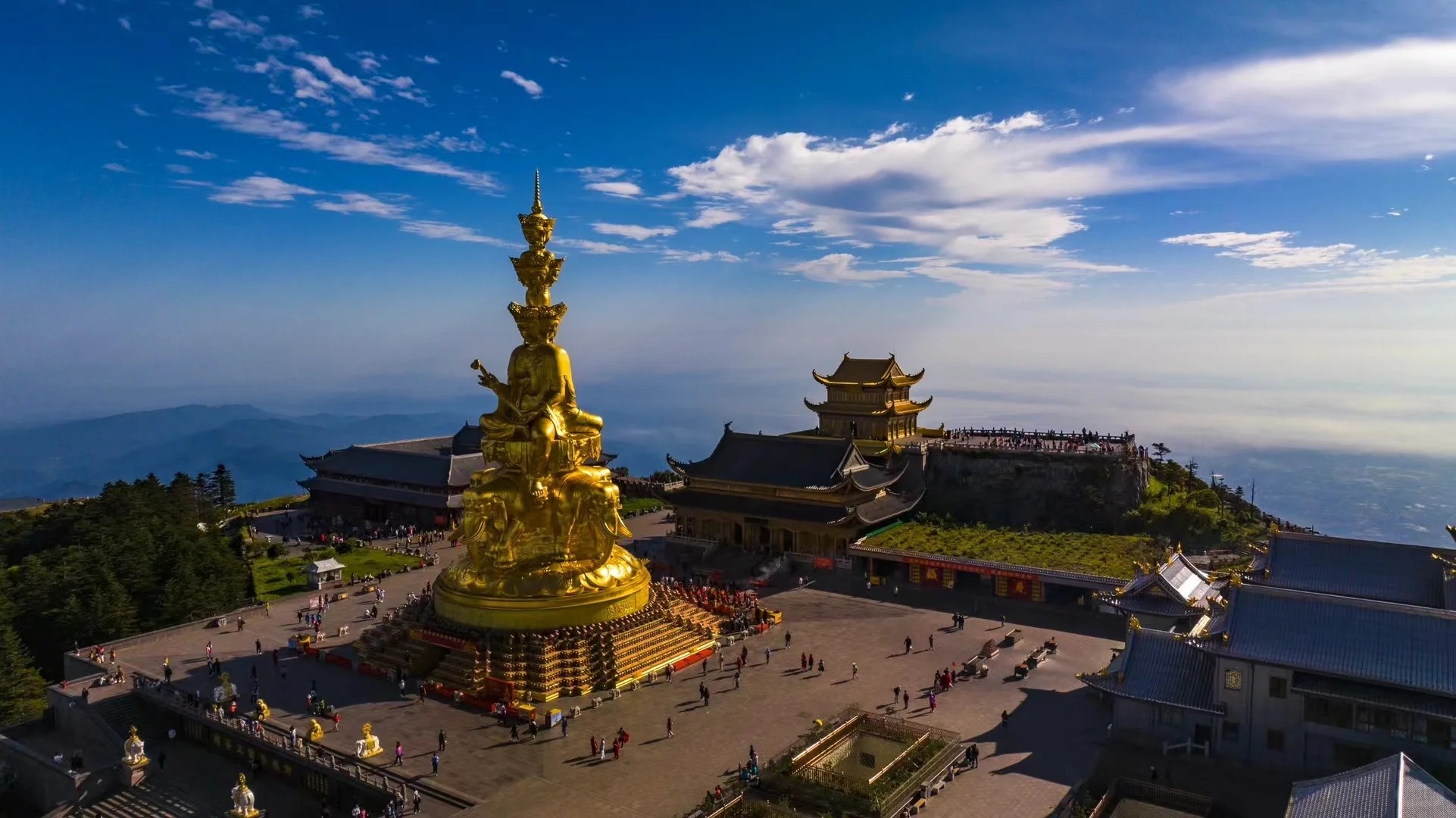Visiting Information
| Information | Details |
|---|---|
| Chinese Name | 峨眉山 (Éméi Shān) |
| Location and Address | Emeishan City, Leshan, Sichuan Province, China |
| Opening Time/Hours | Open all year round, 24 hours a day |
| Entrance Fee | 185 CNY (April to October), 110 CNY (November to March) |
| How to Get There | By Bus: Take bus 5, 9, or Tourist Bus 1 from Emeishan City By Taxi: Available from Emeishan City, about 30 minutes (No metro service available in Emeishan) |
| Best Time for Visit | March to October, with April-May and September-October being ideal |
| Contact Info | +86 833 5098111, [email protected] |
Overview
Mount Emei, located in Sichuan Province, China, is one of the Four Sacred Buddhist Mountains of China and a UNESCO World Heritage Site. Rising to 3,099 meters (10,167 feet), it is known for its breathtaking scenery, rich biodiversity, and significant Buddhist heritage. The mountain is home to over 30 Buddhist temples and monasteries, making it a major pilgrimage site and tourist destination.
Historical Background
Mount Emei has been a sacred site for over 2,000 years. Buddhism was introduced to the area as early as the 1st century CE, and it became one of the first places where Buddhism was established in China. The mountain gained prominence during the Eastern Han Dynasty (25-220 CE) when the first Buddhist temple was built. Over the centuries, it developed into a major center of Buddhist culture and pilgrimage, playing a crucial role in the spread and development of Buddhism in China.

Architectural Features
- Golden Summit: At the top of Mount Emei sits the Golden Summit, featuring the Huazang Temple and a colossal ten-faced, four-armed statue of Samantabhadra (Puxian) Bodhisattva. The golden statue, standing at 48 meters tall, is a magnificent sight and a symbol of Mount Emei’s Buddhist significance.
- Wannian Temple: One of the oldest and most important temples on Mount Emei, Wannian Temple is known for its unique architecture and its bronze statue of Puxian Bodhisattva riding a white elephant, which dates back to the Song Dynasty (960-1279).
- Baoguo Temple: Located at the foot of Mount Emei, Baoguo Temple serves as the starting point for many pilgrims and tourists. It houses numerous cultural relics, including a 25-ton bronze bell from the Ming Dynasty (1368-1644) and ancient sutras.
Cultural Importance
Mount Emei holds immense cultural significance in Chinese Buddhism and broader Chinese culture. It is revered as the bodhimanda (place of enlightenment) of Samantabhadra Bodhisattva and has been a center of Buddhist practice and study for centuries. The mountain has inspired countless works of art, literature, and poetry throughout Chinese history. Its natural beauty and spiritual atmosphere have made it a symbol of harmony between humanity and nature in Chinese culture. Mount Emei is also significant in the development of Chinese martial arts, being the birthplace of the Emei School of martial arts.
Surrounding Attractions
- Leshan Giant Buddha: Located about 40 kilometers from Mount Emei, the Leshan Giant Buddha is the largest stone Buddha statue in the world. Carved out of a cliff face during the Tang Dynasty, it stands 71 meters tall and is an impressive feat of ancient engineering and artistry.
- Emei Hot Springs: At the foot of Mount Emei, these natural hot springs offer a relaxing experience for visitors. The springs are known for their mineral-rich waters, believed to have therapeutic properties.
- Emeishan Butterfly Ecological Park: This park, located near the mountain, is home to hundreds of butterfly species. It offers visitors a chance to observe these beautiful insects in their natural habitat and learn about butterfly ecology.

Photography Opportunities
- Sea of Clouds: One of the most famous sights on Mount Emei is the “Sea of Clouds” phenomenon, where clouds fill the valleys below the peaks, creating a dreamlike landscape. This spectacle is best photographed from the Golden Summit or Jinding Peak, especially during sunrise or sunset.
- Buddha’s Halo: Also known as “Buddha’s Light,” this rare optical phenomenon occurs when the sun casts the observer’s shadow on clouds or mist, surrounded by rainbow-like rings. It’s considered auspicious in Buddhist tradition and makes for stunning photographs when captured.
- Ancient Temples and Natural Scenery: The juxtaposition of ancient Buddhist temples against the backdrop of Mount Emei’s lush forests and dramatic cliffs offers countless opportunities for breathtaking photographs that capture the essence of this sacred mountain.
Modern Importance
- Tourism and Economy: Mount Emei is a major tourist destination, attracting millions of visitors each year. This tourism plays a crucial role in the local economy, providing employment and driving development in the region.
- Environmental Conservation: As a UNESCO World Heritage Site and area of significant biodiversity, Mount Emei is an important focus for environmental conservation efforts in China. It serves as a protected habitat for numerous plant and animal species, including the endangered Tibetan macaque.
- Cultural Preservation: The ongoing maintenance and restoration of Mount Emei’s temples and cultural relics contribute to the preservation of China’s Buddhist heritage and traditional culture. It continues to be an active center of Buddhist practice and study, helping to keep these traditions alive in the modern world.

FAQ
- What is Mount Emei famous for?
Mount Emei is famous for being one of the Four Sacred Buddhist Mountains of China, its stunning natural beauty, rich biodiversity, and numerous ancient Buddhist temples. It’s also known for its “Sea of Clouds” phenomenon and the rare “Buddha’s Halo” optical illusion. - What’s inside Mount Emei?
Mount Emei features over 30 Buddhist temples and monasteries, including the famous Golden Summit with its giant golden statue of Samantabhadra Bodhisattva. It also contains diverse ecosystems with rich flora and fauna, scenic hiking trails, and cable car systems for easier access to higher elevations. - Is Mount Emei free?
No, Mount Emei is not free to visit. There is an entrance fee that varies depending on the season: 185 CNY from April to October, and 110 CNY from November to March. Additional fees may apply for cable cars and some temples. - Is Mount Emei worth visiting?
Yes, Mount Emei is definitely worth visiting. It offers a unique blend of natural beauty, cultural heritage, and spiritual significance. Whether you’re interested in Buddhism, nature, photography, or Chinese culture, Mount Emei provides a memorable and enriching experience. - What to do in Mount Emei?
Visitors can hike the mountain trails, visit ancient Buddhist temples, ride cable cars for panoramic views, watch the sunrise from the Golden Summit, observe wildlife, experience the “Sea of Clouds” phenomenon, and enjoy the hot springs at the mountain’s base. - How do I get to Mount Emei in the local city?
From Emeishan City, you can take bus 5, 9, or Tourist Bus 1 to reach the mountain entrance. Taxis are also available and take about 30 minutes from the city center to the mountain entrance. - How to visit Mount Emei?
To visit Mount Emei, first arrive at Emeishan City. From there, take a bus or taxi to the mountain entrance. You can hike up the mountain or use a combination of buses and cable cars to reach different areas. It’s recommended to spend at least one full day exploring, with many visitors opting for a two or three-day trip to fully experience the mountain. Consider staying overnight on the mountain to catch the sunrise. Always check weather conditions before your visit and wear appropriate clothing and footwear for hiking.



